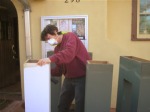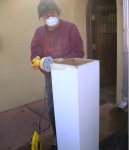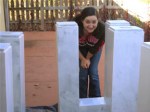Archive for November, 2009
November 25, 2009
The Staten Island Not for Profit Association had two interesting pieces in their latest newsletter:
- Chase and Facebook launch innovative giving program for small and local charities: JP Morgan Chase will give away money to organizations based on the number of votes they receive from Facebook members. Awards are $1 million top prizes, $100,000 for the five runners-up, and $25,000 for 100 finalists. If you can handle that much cash (not every organization is geared up to manage or spend large amounts of money), it might be worth drumming up votes among your Facebook friends and fans. See http://apps.facebook.com.
- New Fame for the Everyday Donor is a New York Times article. The author Stephanie Strom points out that, although non-profits often scour the earth for big donors, going after the little donors may be at least as effective. For example, the average March of Dimes gift is only $14, but those $14’s add up to 22 percent of their revenue. Check it out–the stories she finds are pretty good.
Here’s a small one from the Conference House: This year, because we had a sponsor for our Halloween Harvest Fair, admission was free. Hoping to make up some of the revenue we might be losing,* one of the board members grabbed a big plastic kibbles container, cut a slot in the top, labeled it “Donations,” and put it out at the gate. She was shocked to find out that, by the end of the day, the container contained more than $500.
Moral of the story: Always put out a donation bucket.
* The sponsor couldn’t cover all expenses, so we weren’t sure if food and blow-up ride sales would make up for some of our upfront costs.
Tags:Chase Bank, Facebook, March of Dimes, SINFPA, small donors, Staten Island Not for Profit Association
Posted in Conference House museum, fundraising | Leave a Comment »
November 24, 2009
One of the things you’re always told about working in non-profits (and small businesses) is that you need to be willing to do anything that needs to be done, even if it’s not in your job description.
So last Friday, Kirsten Teasdale and I proved that we’re willing. Meg Ventrudo, executive director of the Jacques Marchais Museum of Tibetan Art, offered us old pedestals, built by Jim Clements (who I know from South Street Seaport Museum, coincidentally), with plexiglass tops.
We’ll use them to display items for or from the Rutan-Beckett House (which is supposed to open FY2010 but no date has been set yet) in the Visitors’ Center.
Here are photos of us in front of the Visitors’ Center. The temperature hovered around 55 degrees F; the paint can said the paint shouldn’t be applied if the temperature was lower than 50 degrees.
-

-
Susan sanding a pedestal
-

-
Sanding with 120 grit paper and a Dewalt sander.
-

-
Kirsten and the primed pedestals
Note: The original connection to the Tibetan Museum was through Materials for the Arts. If you’re in the five boroughs and you’re a non-profit, you need to sign up and visit their warehouse. It’s wonderful: Tons of fabric, furniture, office equipment, paint, paper, etc., etc., and the only cost is a thank-you letter.
If you’re not a non-profit but have good things you need to get rid of, donate them to MFTA. Win-win.
Tags:Conference House museum, Jacques Marchais Tibetan Museum, Jim Clements, Kirsten Teasdale, Materials for the Arts, Meg Ventrudo, Staten Island
Posted in Conference House museum, Jacques Marchais Tibetan Museum, Materials for the Arts | Leave a Comment »
November 9, 2009
My Conference House colleague Kirsten Teasdale and I went to the Historic House Trust-sponsored fundraising workshop on Thursday, July 30, 2009, at King Manor Museum in Brooklyn. The session was moderated by Susan Schear of Artisin and Elizabeth Wagner of JC Geever.
Highlights
Here are the ideas that popped out at me as I reviewed my notes later. The postings following this one expand on them.
- The board members must make their own significant gifts before they can ask others to give.
- Review movement towards strategic-plan goals at least once a year, at the board level and with staff.
- Developing collaborations with other organizations is more useful than worrying about competition. Your competitors aren’t who you’d think they’d be, anyway.
- Do an annual appeal in the fall. If you don’t, your money is being given to someone else who did ask for it.
- Cultivate donors: Look at your membership list to start.
- Board members have to ask the major donors for gifts; major donors want to be asked by peers, not staff.
- When going to foundations for grants, concentrate on the competitive funders, not the mega foundations or the family foundations.
- Find a memorable tagline or value statement around which everyone—board members, staff, docents, members—can rally.
- Use your gift shop to continue educating people after they’ve left the museum.
Tags:Artisin, Elizabeth Wagner, JC Geever, King Manor Museum, Kirsten Teasdale, Susan Schear
Posted in fundraising, gift shop, Historic House Trust | Leave a Comment »
November 9, 2009

Morris Jumel Mansion: George Washington really did sleep here
The workshop presenters, Susan Schear of Artisin and Elizabeth Wagner of JC Geever, talked about mission, vision, and values as very important to strategic planning.
They talked about coming up with a value statement (also called “motto,” “catch phrase,” or ” tag line”). What does your organization stand for? In our case, what does the Conference House stand for? I came up with, “The Conference House helps us understand what it’s like to be on the losing side.” Kirsten’s was better: “The Conference House demonstrates the importance of community dialogue even in the face of unfavorable odds.”
- Having a catch-phrase makes it easy to keep everyone on the same track. Examples: Colonial Williamsburg has “That the Future May Learn from the Past,” YMCA has “We build strong kids, strong families, strong communities.” Morris Jumel Mansion: “George Washington really did sleep here.”
- Everyone associated with us are our ambassadors—our board, our staff, our volunteers, the organizations we work with like, in our case, the South Shore Artists Group, Staten Island Herb Society, the Fishermen’s Conservation Association, the people who walk dogs in the park, our members, etc. Everyone needs to be sending the same message.
- They suggested a motto contest: The winner receives a membership or some other small item as a reward. Or we can set up a survey on our website, with a list of possible mottoes and check-offs: “Which do you like best?”
“Fire people up so that they’re talking about your programs,” the presenters said. Find your success stories and repeat them whenever and wherever possible. Encourage your docents and members to bring the stories they hear back to the office.
Tags:Artisin, catch phrase, Colonial Williamsburg, Elizabeth Wagner, Fishermen’s Conservation Association, JC Geever, Morris Jumel Mansion, motto, South Shore Artists Group, Staten Island Herb Society, Susan Schear, tag line, value statement, YMCA
Posted in friend-raising, Historic House Trust | Leave a Comment »
November 9, 2009
Two Helpful Hints
- In your reports, always tell a funder one new thing that relates to their grant. For example, “Five years ago, we planted apricot trees with donor money and this year they finally bloomed! This is how apricots relate to the Rufus King Mansion….”
- Offer individual contributors behind-the-scenes visits and other materials (DVDs, books, etc.), that you don’t offer to the general public.
Role of the Board in Fundraising
Board members need to:
- Make a personally significant gift. Recommendation: Accept credit cards and have board members charge $X a month to their credit cards as their donation. It helps them and the organization manage cash flow.
- Provide leadership & planning.
- Act as ambassadors to the community.
- Contribute contacts and open their networks to the organization.
- Participate in site visits with funders and government officials.
- Create a development committee.
- Make peer-to-peer asks. This is where the board member’s own gift comes in: “I’ve invested and you should, too.”
The Solicitation Process
Plan and Set Priorities
↓
Write Program Proposal
↓
Compile a List of Potential Funding Sources (the 990s for funders show phone numbers at the upper right corner of the form)
↓
Make an Initial Contact (clear the ask amount in the first phone call)
↓
Submit Proposal
↓
Make an Appointment to Discuss (if appropriate)
↓
Cultivate (one contact a quarter)
↓
Result (send a thank-you even if rejected)
Individual Donors
“People who are philanthropists don’t stop being philanthropists” even in an economic downturn, said the presenters, Susan Schear of Artisin and Elizabeth Wagner of JC Geever. “Almost all start as members, and your role is to train members to be major donors.”
How?
- Look at who’s been giving for 5 or 10 years. Then ask: “You’ve been giving to us for 10 years! Wow! Would you consider giving us more for the Xyz project?”
- As soon as someone gives more than the membership dues, he or she’s a donor.
- There are two types of members: benefits-driven (they want the member’s discount in your store) and philanthropist (they care about your organization’s mission). You need to appeal to both, but differently.
- Events keep potential donors at your site. Make them part of whatever you’re doing.
- Who do the donors know at your organization? The docents, the staff, the board, word of mouth from neighbors of the park?
- Ask board members to sell five tickets to your wine-tasting event or whatever—ask them to open their networks to you, in other words.
Appeals
- Annual appeals—you MUST have an annual appeal at the end of the year. If you don’t ask, someone else will, and they’ll get your money.
- Track what’s happening with the annual appeal. If the letter is about collections and you don’t get much money, then re-evaluate the appeal.
- Always communicate: provide a minimum of three pieces of good news for every ask.
- Make asks compelling—what’s the long-term impact of their gift? How does their gift fill the gaps in your museum’s story?
Major Donors
- What’s a major donor? “There is no rule of thumb except that the check has to feel major to them.”
- Define your major donors, no more than 20. It’s hard to manage more than 20.
- Connect them to the key staff AND the board. The board needs to do this—it’s overwhelming for the staff.
- Provide authentic experiences for the major donors—an attic tour, for example—at least once a year.
- Involve them as volunteers—pick something short-term with defined goals. You can test them out as potential board members using the project (but don’t tell them that).
Tags:Artisin, board of directors, Elizabeth Wagner, JC Geever, major donors defined, peer-to-peer asks, solicitation process, Susan Schear
Posted in board development, fundraising, Historic House Trust | Leave a Comment »
November 9, 2009

Lewis Latimer House
Presenters Susan Schear of Artisin and Elizabeth Wagner of JC Geever said that your competitors aren’t who you think they are—they’re not the other historic houses or local museums, since missions don’t overlap that much.
Rather, the competition is other entertainment venues. For example, competition for the Latimer House is the US Open. Not only are the roads jammed, but airplanes are rerouted overhead so Latimer House can’t hold outdoor programs–too noisy.
Also, NYC museums aren’t necessarily competition for local museums. People staying in Queens hotels, for example, are there for family events and aren’t interested in going to Manhattan. They may be more interested in local museums.
Other things that affect attendance include disease and weather. The Queens County Farm Museum lost a lot of its student groups this fall to the H1N1 virus. Historic Richmond Town on Staten Island loses student groups whenever it rains, since the program requires students to walk from house to house and teachers don’t want those kids getting wet.

Historic Richmond Town
Tags:collaboration, competition, Historic Richmond Town, Lewis Latimer House, non-profit organizations, Queens County Farm Museum
Posted in friend-raising, Historic House Trust | Leave a Comment »
November 9, 2009
Finding and working with collaborators is more important than worrying about competitors, said the conference organizers, Susan Schear of Artisin and Elizabeth Wagner of JC Geever.
Potential collaborators include libraries (libraries will translate brochures and flyers into different languages, they said), hotels, faith-based organizations, chambers of commerce, business improvement districts, restaurants, government agencies, banks, businesses, book clubs, realtors, PTAs, etc.
Hotels are an interesting case, Susan and Elizabeth said, especially ones outside the city (in the boroughs or suburbs). They often host family reunions and after a day or so, family members will be looking for things to do within walking distance of the hotel.
Collaborate on events to:
- Build your brand.
- Get a bigger platform.
- Impress potential donors—donors want to see collaboration.
- Help you and your partner broaden both your networks by sharing email and snail mail lists, for example, or cross-publicizing events in your respective newsletters.
However, be careful to pick the right partner. Don’t dilute your brand; collaborate on something that matches both parties’ missions.
You can also seek grants together, but make sure that it’s in the best interest of both parties—you’ll be stuck with each other if you get the money.
Tags:banks, book clubs, business improvement districts, businesses, chambers of commerce, collaboration, faith-based organizations, government agencies, hotels, libraries, PTAs, realtors, restaurants
Posted in friend-raising, Historic House Trust | Leave a Comment »
November 9, 2009

King Manor Museum
At the King Manor Museum, they have two kids’ programs that bring entire families to the museum:
- Tours for preschoolers and their families—a story and a craft related to the house and a very short tour. The whole program is no more than half an hour. The museum advertised by “handing out flyers at someone else’s park program,” and it’s been growing by word of mouth ever since. The families just love it, said Mary Anne Mrozinski, executive director. (The King Manor Museum is in the middle of busy King Park in Jamaica, Queens.)
- Every child who comes on a school visit goes home with a free voucher for his or her family to come back for a tour. The voucher is good for 2 adults and 3 kids. The museum staff has found that whatever isn’t spent on admission is spent in the gift shop.
Tags:children's programs, free admission, Mary Anne Mrozinski, museum education programs, Rufus King Manor Museum
Posted in family activities, friend-raising, gift shop, Historic House Trust | Leave a Comment »
November 9, 2009

A Jacob's Ladder from Walnut Hill
The take-away during this part of the workshop was: Use your gift shop to continue educating people after they leave the museum.
Kirsten and I had a tour of the shop with the museum educator who had run it for awhile. She provided some interesting information:
- Kids’ gifts sell the most, especially if the goods are no more than $5.
- Candy sells well and it’s cheap to buy.
- They have beautiful adult gifts that stay unsold for years. They recommend against investing in high-end crafts.
- They had a display of Walnut Hill Crafts wooden toys—see http://tavernpuzzles.stores.yahoo.net/walnuthill.html. These toys are popular and fairly inexpensive. Note: Call them to get access to their wholesale store–Walnut Hill Crafts, 660 Old Field Creek Rd, Grassy Creek, NC 28631, 336-982-3022.
- Dover Books on slavery (a theme of the Rufus King Manor) sell well, as do coloring books. Dover Books are inexpensive.
- Bookmarks DO NOT sell well anymore.
- Since most of the buyers are children, lay out the shop with them in mind. For example, don’t put things on high shelves that kids can’t see. Light it well.
- For seasonal events, sell a subset of your goods outside the shop; sell a signature item.
Tags:designing for children, museum gift shop, ongoing education
Posted in gift shop, Historic House Trust | Leave a Comment »






